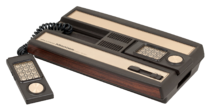Intellivision emulators

| |
| Developer | Mattel Electronics |
|---|---|
| Type | Home video game console |
| Generation | Second generation |
| Release date | 1979 |
| Discontinued | 1990 |
| Introductory price | $299.99 |
| Successor | Amico (Intellivision) HyperScan (Mattel) |
| Emulated | ✓ |
The Intellivision was a game console produced by Mattel in 1979. It had a GI CP1610 CPU at 1 MHz. It had 524B of RAM and 932B of graphics RAM. It was notably more powerful than the Atari 2600, which was released at a similar time, and could be used with a voice synthesizer unit known as the Intellivoice, which allowed speech in its games.
Contents
Emulators[edit]
| Name | Platform(s) | Latest Version | Intellivoice | ECS* | KBC* | Accuracy | libretro | Retro Achievements |
FLOSS | Active | Recommended |
|---|---|---|---|---|---|---|---|---|---|---|---|
| PC / x86 | |||||||||||
| jzIntv jzIntvImGui |
2.3.7(jzIntvImGui) 20200712(jzIntv) |
✓ | ✓ | ~ | High | ✗ | ✗ | ✓ | ✗ | ✓ | |
| MAME | 0.264 | ✓ | ✓ | ~ | Mid | ✓ | ✗ | ✓ | ✓ | ✓ | |
| FreeIntv_libretro | libretro core | ✗* | ✗* | ~ | ? | ✓ | ✓ | ✓ | ✓ | ✓ | |
| Nostalgia | 5.0 | ✓ | ✓ | ~ | Mid | ✗ | ✗ | ✗ | ✗ | ~ | |
| Pantheon | 13.640 | ✓ | ✗ | ~ | Mid | ✗ | ✗ | ✗ | ✓ | ✗ | |
| Bliss | 2.0.5 | ✓ | ✓ | ~ | Low-Mid | ✗ | ✗ | ✓ | ✗ | ✗ | |
| Mobile / ARM | |||||||||||
| jzIntvImGui | 2.3.7 | ✓ | ✓ | ~ | High | ✗ | ✗ | ✓ | ✓ | ✓ | |
| FreeIntv_libretro | libretro core | ✗ | ✗ | ~ | ? | ✓ | ✓ | ✓ | ✓ | ✓ | |
| Jzintv4droid2 | 1.0.3 | ? | ? | ~ | Low-Mid | ✗ | ✗ | ✗ | ✗ | ~ | |
| Console | |||||||||||
| jzIntvImGui | 2.3.4 | ✓ | ✓ | ~ | High | ✗ | ✗ | ✓ | ✓ | ✓ | |
| FreeIntv_libretro | libretro core | ✗ | ✗ | ~ | ? | ✓ | ✓ | ✓ | ✓ | ✓ | |
| NINTV-DS | 5.0a | ✓ | ✓ | ~ | Mid | ✗ | ✗ | ✓ | ✓ | ✓ | |
| PSPInt | 1.1.0 | ? | ? | ~ | Mid | ✗ | ✗ | ✓ | ✗ | ✓ | |
Comparisons[edit]
- jzIntv: Portable, no-frills Intellivision emulator. Probably the most complete and accurate Intellivision emulation available. Made by Joseph Zbiciak.
- MAME (Formerly part of MESS): This multi-system emulator is presumed to have good support for the all released Intellivision models and add-ons - ECS and Intellivoice (eg. Keyboard Component); some mechanical things still not implemented.
- Nostalgia: Pretty much the very best Intellivision emulator available at the time by 2009. Made by Joe Fisher.
- Pantheon: Popular multi-system emulator for Windows OS covering many old computers and 1970's-1980's consoles. Shown to support Intellivoice games but no ECS games work in this software yet. Made by Boštjan Grandovec.
- Bliss: First developed in early 2000's then abandoned. Afterwards, the author, Kyle Davis, tried to code it in C# and add portability but then decided to return to C++ and a simpler codebase. It has good support of Intellivoice and ECS's games but was unfortunately abandoned without much notice in 2006. Code on GitHub.
List of old known Intellivision emulators. Downloads of old emulators. Emulators not included above:
- IntelliWare: Emulator and development kit for Intellivision. Made by Valter Prette.
- Intellivision Lives: Commercial emulator from the current copyrights owners (Blue Sky Rangers) for many of the original Intellivision games.
- IntvWin/IntvDOS: Little is known about this one. Made by John Dullea, author of PCAE (Atari 2600 emulator). IntvWin 1.1 released in 2002. The author added WinXP compatibility in IntvWin 1.3 in 2007 (File can be found at GameTronik.).
- jzIntv Launcher: Complete GUI (Graphical User Interface) frontend and menu utility for the Windows version of Joe Zbiciak's jzIntv Intellivision emulator. Made by Rich Nagel.
Frontends for jzIntv[edit]
- gtk-jzintv (Linux)
- jzIntvGUI
Keyboard Component & The ECS[edit]
Placeholder text
* Entries for "ECS*" and "KBC*" in the table above should be explained here.
Overview[edit]
At the end of 1979, Mattel Electronics' Intellivision console was poised as a competitor to the number one selling console in the market, the Atari 2600.
After Mattel sold the rights to the system soon afterwards, the Intellivision was kept alive through their new owners, INTV Corp. Another 35 games were released from 1985 to 1990, mostly through mail order service. The system was generally very successful in the end, with over 3 million units sold and 125 games released before the system was finally discontinued in 1990.
During its lifetime, several models of the base system were released, as well as some interesting peripherals including a full computer adaptor, music keyboard, Intellivoice speech synthesis module, system changer to play Atari VCS games and PlayCable (an accessory to download games from your cable provider).